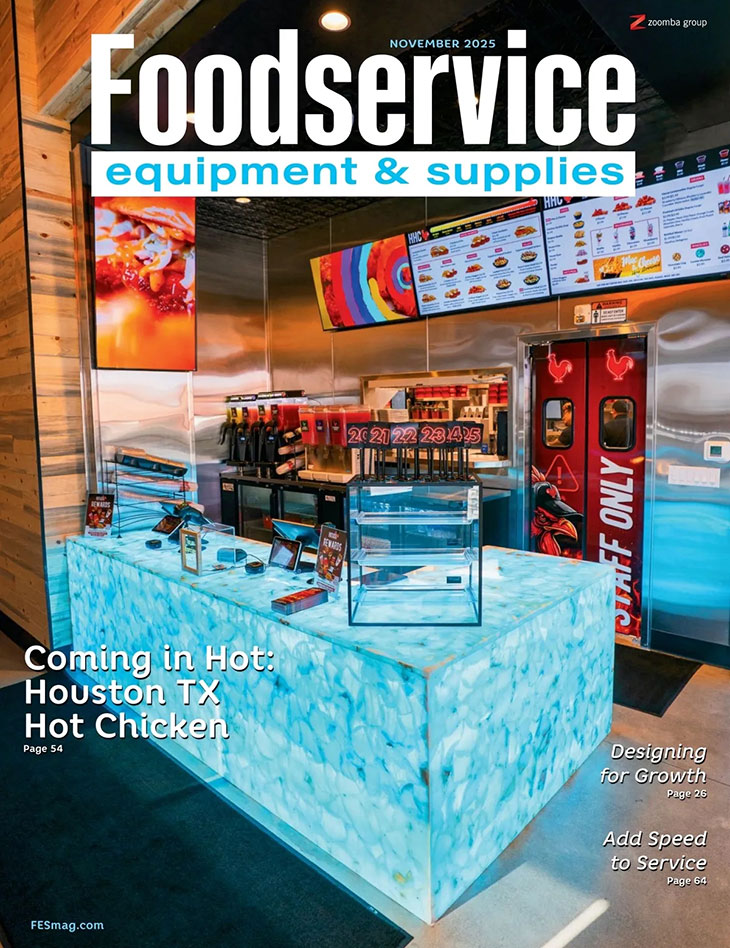Who will fix the robots? What’s percolating at Starbucks? How did restaurant sales fare in May? Can a buffet chain make it in the fast-casual world? What’s a “Tacotender” and where can you find one? Answers to these questions and more This Week in Foodservice.
Changes are a brewing at Starbucks.
The Seattle-based coffee chain plans to roll out a new staffing and service model that calls for hiring additional personnel and better leveraging technology, per a Reuters report. Starbucks had tried out the approach at 700 stores, which resulted in faster service times and increased sales. This approach uses technology to more efficiently sequence orders and dedicates a barista to the drive thru.
Starbucks also plans to test a generative artificial intelligence assistant at 35 of its stores, per a CNBC story. Instead of flipping through manuals or accessing Starbucks’ intranet, baristas will use a tablet behind the counter to get answers to a variety of questions, from how to make a specific drink to troubleshooting equipment errors.
These are among a handful of changes coming to Starbucks. The chain’s “starting five” approach will allow it to quickly deploy and test ideas across, you guessed it, five coffee house locations. Starbucks also plans to modernize its food and beverage offerings.
Foodservice News
- Operating conditions may be a little tighter, but consumers remain satisfied with the experience restaurants provide. According to data from the American Customer Satisfaction Index Restaurant and Food Delivery Study 2025, quick-service restaurants maintain a steady customer satisfaction score of 79 on a 100-point scale. Full-service restaurants, despite slipping 2% for a reading of 82, remain one of the highest-rated industries in the study. For the 11th consecutive year, Chick-fil-A was the restaurant with the highest score. Texas Roadhouse and Longhorn Steakhouse were the leaders among sit-down restaurants.
- Consulting firm Point B opened a restaurant technology innovation center in Chicago. The facility allows restaurant operators to “test modern technologies in a live environment,” per a release announcing the new venue. The facility includes commerce platforms, back-office systems, kitchen displays, kiosks, loyalty, tipping systems, and digital menu/order confirmation boards, all with AI woven throughout.
- Can a fast-casual concept make it in the full-service segment? Fuzzy’s Tacos aims to find to find out as the fast-casual chain opened its first full-service location, per a Nation’s Restaurant News story. Unlike traditional Fuzzy’s locations where guests order at the counter and collect their food at a pickup window, this Sugar Land, Texas location includes “Tacotenders” who take and deliver their orders tableside.
- Keke’s Breakfast Café is preparing for a growth spurt. Three years after Denny’s acquired it, the 74-unit family dining chain plans to grow its store count by 25% to 30% annually, per a Restaurant Business story. If that holds, it will be the most locations Keke’s has ever opened in a year. The chain spent the past few years redesigning its restaurant prototype, investing in digital marketing, and embracing customers who choose to dine off premises, the story adds.
- The value of chicken chains has really taken flight. In 2019, The Jordan Company LP and Durational Capital Management LP acquired Bojangles for $593.7 million, per a QSR Magazine story. Just six years late,r the chain is for sale again and could fetch more than $1.5 billion. Bojangles has more than 800 units systemwide with more on the way.
- Savory Fund has an appetite for Asian street food. The burgeoning restaurant investment firm acquired Hawkers, a 15-unit chain based in the Southeastern U.S. with AUVs of $4.6 million, per a release announcing the deal. Hawkers has a presence in such markets as Orlando, Atlanta, Dallas, Charlotte, Nashville and Washington, D.C. The next phase of expansion will double down on these markets, helping Hawkers grow deeper roots, the release added. Savory Fund’s restaurant portfolio now includes 13 different chain concepts.
- Golden Corral plans to open a second fast-casual location later this year, per a Restaurant Dive story. Known as Golden Corral Favorites, the restaurant will be in Richmond, Va. The concept is part of the chain’s plans to create more flexibility with its real estate options, allowing it to fit into more markets.
- Insomnia Cookies updated its ownership amid plans to accelerate its growth. Krispy Kreme sold its stake in the late-night bakery brand to Verlinvest and Mistral Equity Partners, who were already investors in Insomnia Cookies. The transaction was valued at $75 million, per various published reports. Insomnia Cookies plans to grow to 1,800 units over the next decade. It has 350 locations across the U.S., Canada, and the U.K.
- A key question about the use of robotics in foodservice has been partially answered. As robotics slowly makes its inroads into the industry, a natural question to ask is “who will handle repair and maintenance?” Restaurant robotics and AI provider Miso has inked a deal with Roboworx for nationwide after-market support. As part of the deal, Roboworx will support both new installations and the existing installed base of Flippy Fry Stations. Roboworx field service technicians will lead deployments, conduct preventative maintenance, provide on-demand service, and perform regular customer success check-ins.
Economic News
- U.S. retail sales declined 0.9% in May compared to the previous month, per data from the U.S. Commerce Department. This decline is 0.2% more than economists polled by Reuters had projected. The decline in sales was attributed to a dip in motor vehicle purchases as a rush to beat potential tariff-related price hikes slowed. Consumer spending, though, remains supported by solid wage growth for now, Reuters added. In addition, the Commerce Department revised its April sales data to show a 0.1% decline for the month instead of a 0.1% gain as previously reported. Sales at foodservice and drinking places also declined 0.9% in May compared to the previous month.
- The Consumer Price Index increased 0.1% in May, which means the contributed to an annual inflation rate of 2.4%, the U.S. Bureau of Labor Statistics reported. Economists surveyed by Dow Jones had been looking for respective readings of 0.2% and 2.4%, per a CNBC story. Both grocery and restaurant prices increased 0.3% for the month. For the 12 months ending in May, restaurant prices increased 1.6% more than grocery prices.
- Industrial production fell 0.2% in May, per data from the U.S. Federal Reserve. This comes after a 0.1% April increase. Manufacturing output increased 0.1% in May due to a 4.9% gain in the index for motor vehicles and parts. The index for manufacturing excluding motor vehicles and parts fell 0.3%. The index for utilities decreased 2.9%. At 103.6% of its 2017 average, total IP in May was 0.6% more than its year-earlier level. Capacity utilization moved down to 77.4%, a rate that is 2.2 percentage points less than its long-run (1972–2024) average.
- The Producer Price Index for final demand advanced 0.1% in May, the U.S. Bureau of Labor Statistics reported. Final demand prices declined 0.2% in April and 0.1% in March. The BLS attributes the May increase to final demand services, which advanced 0.1%. Economists polled by Reuters had forecast the PPI rising 0.2% after a previously reported 0.5% drop in April.



